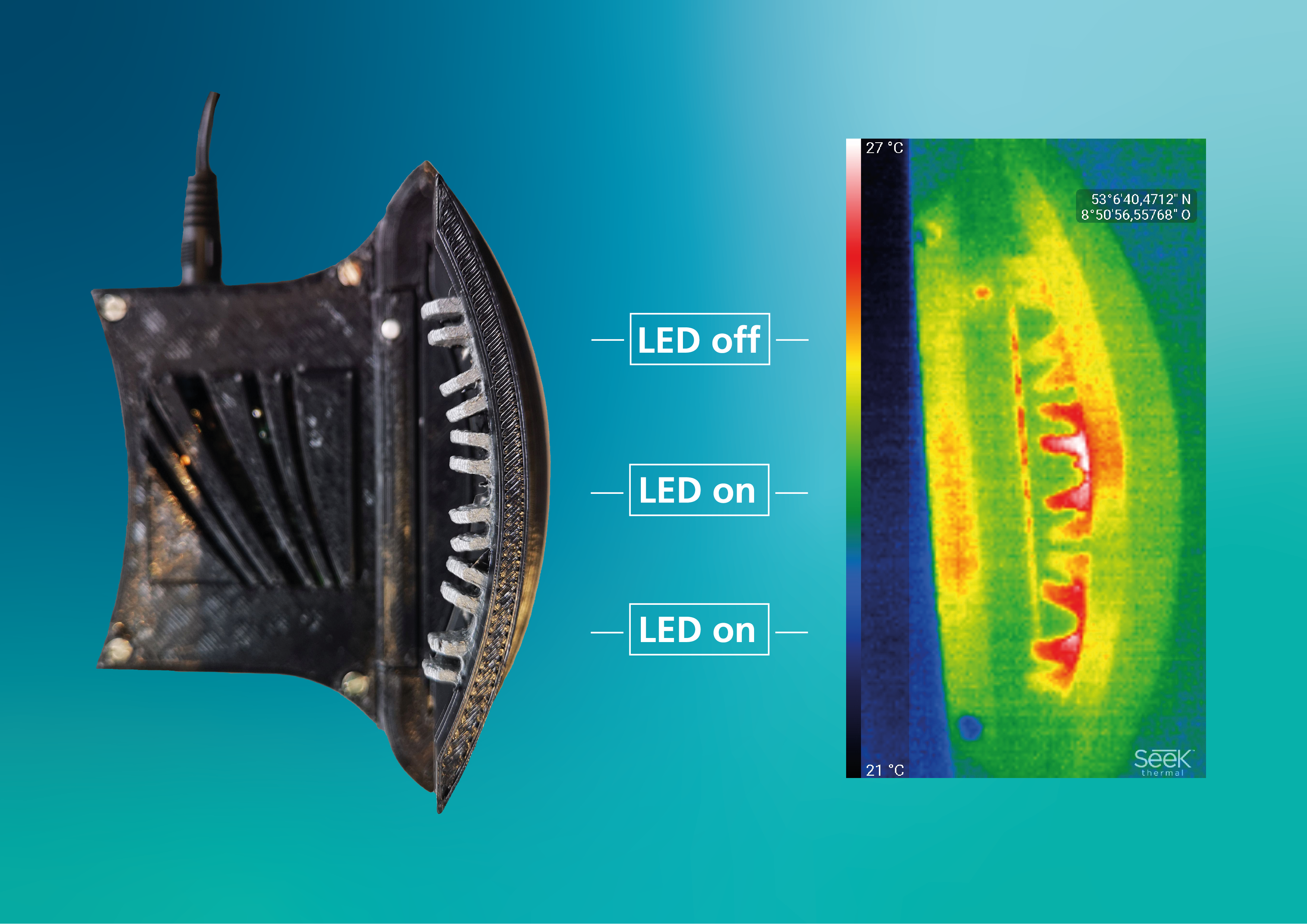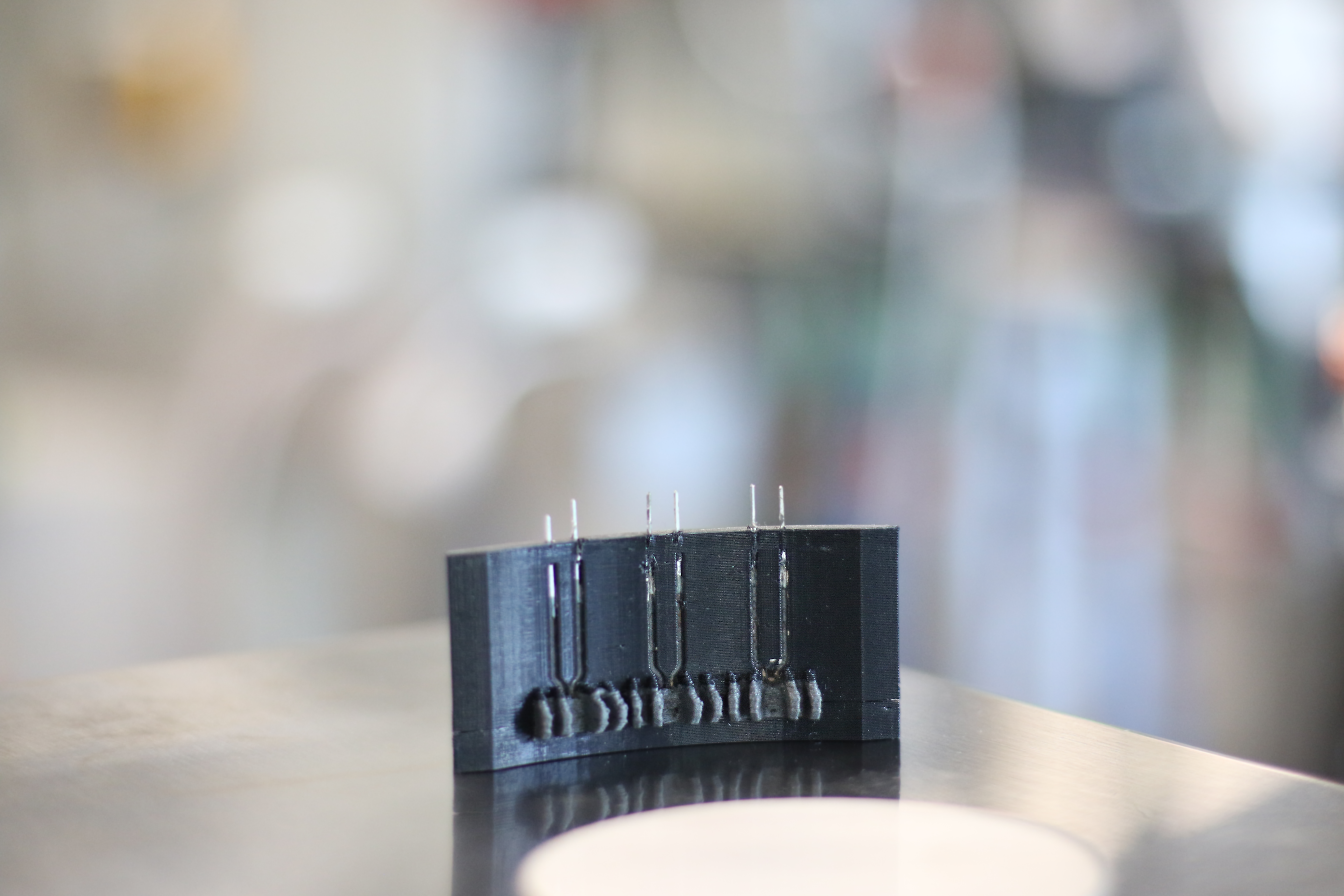Thermally conductive heat sink material for 3D printing and function integration of electronics

The integration of electronics or LEDs in additively manufactured plastic components involves heat dissipation during operation. Using 3D printing (Fused Filament Fabrication, FFF), thermally conductive plastic composites can be used as heat sinks. The material and process development for applications in the automotive and lighting sectors was part of the »Hyb-Man – Hybrid 3D Manufacturing of Smart Systems« project.
Performance of thermally conductive composites
Plastics are bad thermal conductors, the thermal conductivities are typically only around 0.2 W/mK, while metals have very high thermal conductivities (aluminium, steel 20 W/mK; copper, boron nitride >300 W/mK) – but often with high electrical conductivity at the same time. Plastic composites filled with highly thermally conductive powder or fibres can achieve thermal conductivities of more than 10 W/mK without losing their good processability.
For this purpose, the material is produced in a special compounding process. The quantitative proportions of the individual material components can be varied in the same way as the type of individual materials themselves. As matrix polymers, thermoplastic elastomers (TPE) can be used in addition to a range of thermoplastics such as PA 6, PA 6.6, PA 12, PP, PPS, ABS, etc. Solid and molten metallic substances as well as carbonaceous or ceramic powders can be incorporated into the plastic melt as additives.
Production of functional composites at Fraunhofer IFAM
Thanks to a special compounding process, Fraunhofer IFAM is able to realise a very high filling level of the aggregates of up to 50 % by volume compared to other composite variants. As a result, the composite combines good chemical resistance, low weight and easy processability of the polymers with the good thermal conductivity of the metals or ceramic substances. Despite the high possible filling degrees, the material can be processed under almost consistently good processing conditions on the commercially available machines and systems in the plastics industry.
Processability in 3D printing
For 3D printing (also called fused filament fabrication, or FFF for short), the composite granulate is extruded into filaments with a homogeneous microstructure, the geometric quality is checked and the filaments are assembled onto spools. The materials can be printed directly on commercially available 3D printers. This makes it possible to produce 3D printed components from several materials with special properties and, for example, to integrate electronic components, connect them via printed conductive paths or print customised heat sinks. Processing of the functional composites directly from the pellets by means of innovative 3D pellet printers and other plastic processing methods such as injection moulding or extrusion is also possible, as well as calendering or pressing.
Flexible first production of smart systems
In the project »Hyb-Man - Hybrid 3D Manufacturing of Smart Systems«, Fraunhofer IFAM, together with a consortium of 10 partners from the Netherlands and Germany, has developed hybrid 3D manufacturing processes. These enable flexible first production of smart systems for lighting and automotive products. The new hybrid 3D manufacturing process uses additive manufacturing as the central production technology, combined with the assembly and integration of electronic parts.
Under the direction of Dipl.-Ing. Arne Haberkorn, Fraunhofer IFAM activities in the project focused on the development of new highly conductive materials for 3D printing (FFF) and on the combination of FFF and dispensing in one process. For demonstration purposes, a component with integrated LEDs was designed and realised using 3D printing (FFF). For this purpose, the plastic housing was printed from conventional polymer and the cooling fins for the LEDs from highly conductive polymer composite in one process.
The »Hyb-Man« project was funded, among others, by the BMBF (FKZ: 16ES0624) in the research programme "ICT 2020 - Research for Innovation" as part of the EUREKA cluster PENTA, which supports innovations in the field of micro- and nanoelectronic components and systems.
 Fraunhofer Institute for Manufacturing Technology and Advanced Materials IFAM
Fraunhofer Institute for Manufacturing Technology and Advanced Materials IFAM